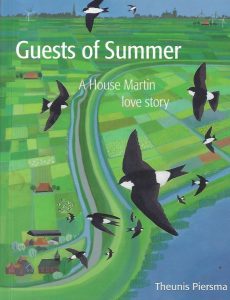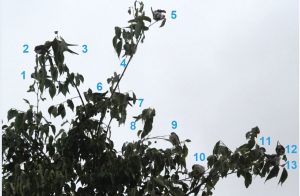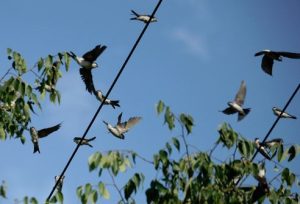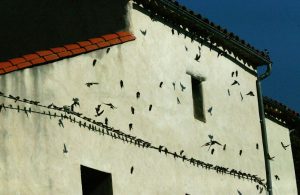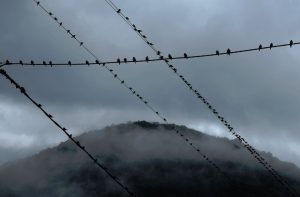Guests of Summer, A House Martin Love Story. By Theunis Piersma. Thetford, BTO Books. 115pp.
First published by Bornmeer as Sweltsjesbfan Gaast in 2004. Undated but published 1 March 2016 Foreword by Ian Newton. ISBN 978-90-858-157-0-9 9 789085 815709 A review:
First published in Frisian, this book is an English translation of the second version in Dutch, but who would know. It reads incredibly well and there are no awkward phrases; great work by the translator.
The book is an entirely house martin-centric book, written by a house-martin-centric author who is also a professional birder, so other species are mentioned (rarely) only by way of comparisons or setting the scene for the demise of avifauna. The author lives in the wetland-rich area of the Frisian countryside of northern Netherlands and the book centres on life in the village of Gaast and the intimate goings-on of house martin behaviour in the parish. They do quite a lot of nest hopping, even rape, but then that is probably altruistically better for the species in terms of getting their genes abroad. Going abroad is however the problem of where do the birds fly too exactly?
I love the chapter on orcas since the striking black and white colours of house martin remind the author of the colour scheme of orcas, quite so says I, and reminds me of my own book on ‘Black and White in Animals’ (2019) which incidentally figures a partial albino barn swallow whose genetic material has been possibly been interfered with by radiation from Chernobyl. Piersma says that ‘house martins and orcas look alike’ that they ‘live in their own shadow’ because of their colour scheme, and that house martins take prey from below because of it.
But back to this love story. The book is written as 29 vignettes, or chapters, of information, which tell a sequential story of the life of the house martin through the eyes of villagers, whose observations about the sounds, solicitations and facial peeps from the nest mean so much – as Piersma tries to interpret. The birds are clearly conscious of us, people, and react accordingly. Interpreting the facial expressions of their little faces in the nest does require a lot of field work sitting around in a chair!
I don’t think I have reviewed a book with such short chapters. This is completely different oeuvre where often a small but highly relevant piece of ecological information is played out in a short chapter. The way that it is written is incredibly enthralling. Ian Newton says in the Foreword that wherever you dip into the book ‘there is interesting stuff’. I completely agree. It is a complement that the author, a scientist has been able to write very clearly without being burdened with scientific jargon, and it is immensely readable. I have now reviewed a few hundred books so I do find it very accessible and completely different to any other natural history books. It should be a requirement of all scientists to write a hugely interesting and popular account of their research subject without using complicated jargon, and in this case without Dr. Piersma referring to his 400 scientific publications.
For the British reader there much to enjoy. Piersma sets the scene whereby Friesland was connected to England via the ‘Mare Friscum’ as shown in his map for the period 600-800 AD. He makes bird and human connections between East Anglia (the Sutton Hoo site) where there is Anglo-Saxon overlap in languages and DNA. Swallows would have been in the buildings, but not particularly house martins, they were on cliffs. Gilbert White’s opinion on overwintering martins is discussed. In terms of answers we have not moved on a lot. We still do not know exactly where all the martins go for winter.
The book is mostly about house martins, but there is a lot about sand martin, barn swallows (the hirundines trio) and swifts too. Swifts are more related to humming-birds and owls, but the hirundines and the swift portion-out the air space, house martin trawls the air at 2km up – they have feathered legs possibly to insulate against the cold temperature, swifts tuck their legs away and fly much higher (radar tells us this): both sleep on the wing, and barn swallows are low-lying hedge-hoppers.
The decline of house martins is discussed in relation to changes in agriculture. Piersma shows that the decline in Britain has mostly occurred across the country from north-west to south-east which, he says is an ‘easy fit’ with agricultural intensification. In his own country the numbers of Barnacle geese has ‘strongly increased’ over 1970-90s whilst the numbers of house martins has ‘strongly decreased’ over the same time. He reflects how meadows have decreased by 95%, and how the flowers are no longer there for the birds to feed on the associated insects. The decline is not through a lack of nest sites as one stone bridge near Oxford used to have 400-500 nests in the 1950s but none now: the bridge is still there (Clifton Hampton bridge) so here is a little 2022 project for Oxford members of the HMCUK&I to check out the Oxfords bridges!
As to where the birds go for winter a little bit more of the jigsaw is coming into place. Analysing the hydrogen isotopes in the feathers indicated that the Gaast house martins actually go to Africa, south of the Sahara and into the Congo, trawling the rainforest canopy possibly benefiting from flying termites.
We learn that returning house martins tend to go to old nests on northern aspects, that a single nest takes at least 1000 journeys to construct and that nesting building needs to be near muddy locations. Some martins are clay thieves and sometimes nick others pieces of nest. Piersma has never seen House Martin mate, they possibly do this in the nest. And maybe that they sleep communally in nests too. Eleven is the total recorded to exit one nest. There is still so much to find out, questions to be asked.
For my own interest in house martins, I always think the house martins that choose to breed around the Mediterranean have a better time that those who go to Scotland or even Iceland, since there are plenty of insects around the Camargue delta, and one could still fit in a third generation. I am familiar with hundreds of house martins regularly falling out of the sky and landing on houses, even trees ahead of summers storms in the Cévennes mountains. Piersma says that they rest on trees sometimes, yet my observations are that this is a regular occurrence when all wires and houses are occupied by birds which are natural self-spacers.
As far as I know there are no comparable books on house martins. There are no photos in this book (it does not need them), but there is an exhaustive list of references. All house-martin-centric persons should read this book, indeed all those who like the swifts and swallows and birds in general. It is hard to swallow that we tend to know a wee bit more about house-martins around the nest, but still very little about where they go abroad. The mysteries continue. John Feltwell
The book is available from BTO books
House martins resting on a Nettle tree, Celtis australis. Cévennes
Social-distancing on wires and gripping masonry Cévennes
Resting up after a storm Cévennes all photos (c) John Feltwell
